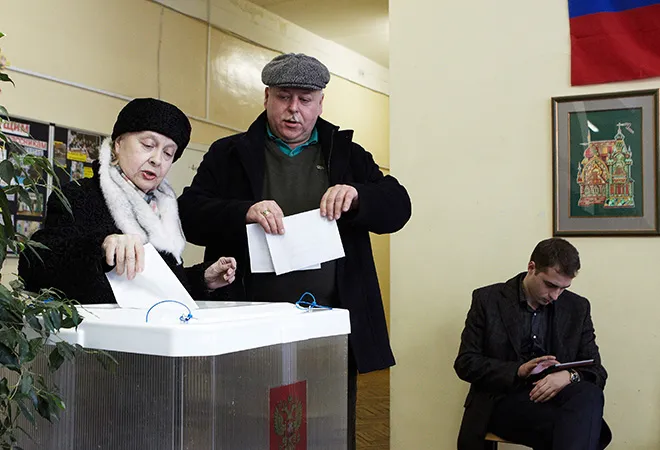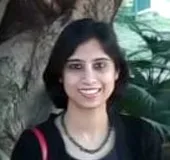
On September 9, Russia went to polls in a single day voting - 16 regions electing their governors, 13 regions voting for legislatures, four by-elections to the State Duma and other city/municipal level elections including the city of Moscow – adding to 6000 elections at different levels in 85 regions.
The elections to the Moscow city duma followed two months of sustained protests against non-registration of independent, and some opposition candidates. The protest took place against the backdrop of an economic slowdown that has seen real incomes stagnate for the sixth consecutive year. Also, the anger against the unpopular pension reforms of June 2018 resulted in a steady fall in rating of the ruling United Russia (UR) party that touched 28% in August 2019, having stood at 63% in June 2016.
The elections and the results
The unpopularity of UR this year forced some of its members to register themselves as independent candidates in the Moscow city duma elections. The party did manage to secure a majority in the 45-member body with 25 seats but its majority has gone down significantly. The Communist Party (CPRF) increased its tally from 5 to 13, benefitting most from the ‘Smart Voting’ tactic launched by opposition leader Alexei Navalny. So much so that the only two candidates to poll more than 50 percent of the votes were Communists. Just before the election, Navalny galvanized his supporters by urging them to vote for candidates who could defeat UR candidates.

It is estimated that almost 20 seats were won by candidates endorsed by Smart Voting and in a few others, the UR victory was close. In an election characterized by a low voter turnout of 21.77%, the opposition was able to make a dent in the ruling party’s hold but failed to bring about a change of power. Also, the non-systemic opposition continues to remain out of power, with only registered parties making it through to the duma.
In the gubernatorial elections 13 interim governors and three sitting ones won comfortably – unlike in 2018 when four Kremlin-backed candidates were forced into a second round run-off. The opposition, in this case the Liberal Democratic Party of Russia (LDPR) was only able to take control of the regional parliament in Khabarovsk winning 34 of the 35 seats. In 2018, the region had elected an LDPR governor through popular vote.
The victories of the ruling party have been attributed both to pre-election manoeuvring at the highest level as well as weakness of the opposition parties in the region. Through 2018 and 2019, to counter the anti-incumbency factor, the President appointed interim governors in 13 of the 16 regions that went to the polls.
The margin of UR’s victory has been comfortable, with only Sakhalin and Altai governors polling less than 60% of votes. While six of the sixteen registered as independent, preferring not to openly align with UR, none of them belonged to any opposition party.
The victory, despite the falling ratings of UR, is aided by the careful ‘application of administrative technologies’ in ‘earlier stages of the electoral process’ by the Kremlin to prevent any unexpected developments. At the regional level, the tool for this is ‘municipal filter’ introduced in 2012 and modified subsequently which mandates all candidates at regional and municipal level to get 5-10% percentage of signatures from deputies and heads of municipalities.
Since UR as the dominant party controls most of these legislative bodies, its deputies use their power under the law to weed out opposition candidates, leaving the final gubernatorial contest a walkover for the incumbent. The parties who make it to the State Duma – the systemic opposition – get a much better treatment as compared to the non-systemic opposition.
A popular method to disqualify potentially dangerous opposition candidates, which gave rise to much ire in Moscow leading to large-scale protests in July and August, is the requirement for a certain number of signatures to register as a candidate. Although the rejections triggered the protests, it must be noted that this tactic has been used earlier and is not a new invention.
Research indicates that since 2005 in about 20,000 mayoral elections, UR candidates got rejected only 0.3% times while for independent candidates this figure was at 13.9%. The same figure for LDPR, Communist Party of Russian Federation (CPRF) and A Just Russia stands at 4.3, 3.7 and 4.2 per cent respectively.
Also, those independent candidates who are more likely to win have a higher chance of being rejected, bolstered by the fact that people react with less anger towards the manipulation of municipal filters as compared to outright malpractice, with the protests in Moscow being an exception in this case for Russia till now.
The road ahead
The September elections mean that the Kremlin has seen-off immediate challenge to its power. However, mounting economic concerns and a robust non-systemic opposition using online methods of mobilization remain causes of concern before the 2021 State Duma elections. There has been a sharp increase in number of protests on socio-political issues. While citizens still are more wary of political protests, the government line of Moscow protests being sponsored by the West were not believed by 58% of the people.
The subsequent raids on Navalny’s supporters across 43 cities over an alleged money laundering case also point to unease at the highest level. In 2017, Navalny was barred from taking part in the 2018 presidential election due to his conviction in a case that the European Court of Human Rights criticized for not giving him ‘a fair hearing.’
The use of legal and institutional means to manipulate elections is not an uncommon practice. However, a continued decline in its popularity ratings remains a concern ahead of the 2021 parliamentary elections. Since the party also helps mobilize support in presidential elections, its popularity is important both for exercising control over politics and the elite as well as presenting a veneer of legitimacy.
The opposition parties like CPRF and LDPR have seen their ratings remain steady at 11 and 10% respectively despite the decline in UR’s popularity, indicating that the latter’s loyalists have not shifted to the existing opposition parties but remain undecided in absence of credible alternatives. The non-systemic opposition, which is not part of municipalities/regional assemblies/State Duma also need to come up with a strategy in the post-election period that goes beyond Moscow and St. Petersburg.
The success of smart voting in Moscow did suggest the mood among the citizens of the capital city who wanted to defeat UR and demonstrated the appeal of the non-systemic opposition even when its ‘locked out.’ But it raises questions of throwing support behind candidates with widely differing ideologies, with the sole aim of defeating the “party of power”. The possibility of them falling out cannot be ruled out as their ideologies remain varied.
The viability of this strategy at a nation-wide level remains suspect and does not necessarily add to the strength of the independent, non-systemic opposition. This and the ruling party’s “organisational structure and media capacity” would be challenges for the opposition as it plans for elections in 2020.
Conclusion
That the unpopularity of UR has not translated into victory for the opposition in the regions points to the latter’s weakness. The weak party system has led to questions about the quality of democracy in Russia and the 2021 State Duma elections would be a test. The artificial selection of candidates, suppression of opposition voices, practice of using pretext of being an ‘independent’ candidate all weaken the party system and point towards fragile institutions open to manipulation.
The non-systemic opposition faces the daunting task of increasing its support among the people, establishing a common agenda with the systemic opposition to emerge as real challengers to UR, which otherwise could retain power despite its growing unpopularity.
The views expressed above belong to the author(s). ORF research and analyses now available on Telegram! Click here to access our curated content — blogs, longforms and interviews.





 PREV
PREV


